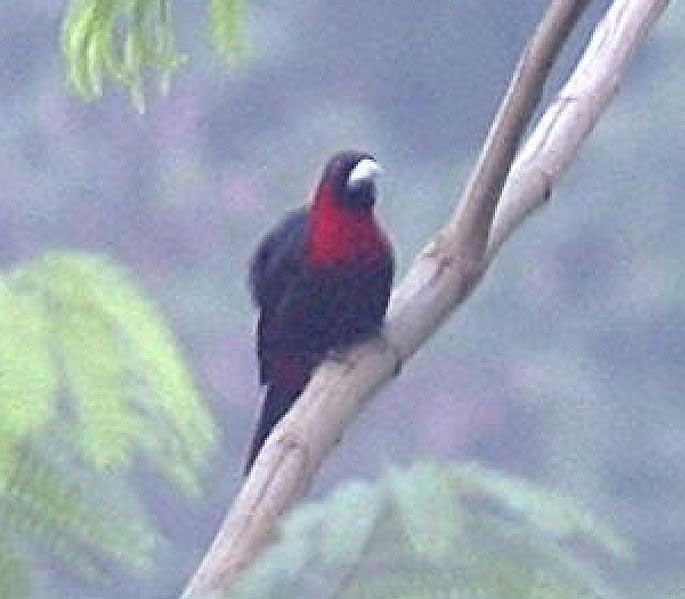
Ramphocelus sanguinolentus (*)
Superregnum: Eukaryota
Cladus: Unikonta
Cladus: Opisthokonta
Cladus: Holozoa
Regnum: Animalia
Subregnum: Eumetazoa
Cladus: Bilateria
Cladus: Nephrozoa
Superphylum: Deuterostomia
Phylum: Chordata
Subphylum: Vertebrata
Infraphylum: Gnathostomata
Megaclassis: Osteichthyes
Cladus: Sarcopterygii
Cladus: Rhipidistia
Cladus: Tetrapodomorpha
Cladus: Eotetrapodiformes
Cladus: Elpistostegalia
Superclassis: Tetrapoda
Cladus: Reptiliomorpha
Cladus: Amniota
Classis: Reptilia
Cladus: Eureptilia
Cladus: Romeriida
Subclassis: Diapsida
Cladus: Sauria
Infraclassis: Archosauromorpha
Cladus: Crurotarsi
Divisio: Archosauria
Cladus: Avemetatarsalia
Cladus: Ornithodira
Subtaxon: Dinosauromorpha
Cladus: Dinosauriformes
Cladus: Dracohors
Cladus: Dinosauria
Ordo: Saurischia
Cladus: Eusaurischia
Subordo: Theropoda
Cladus: Neotheropoda
Cladus: Averostra
Cladus: Tetanurae
Cladus: Avetheropoda
Cladus: Coelurosauria
Cladus: Tyrannoraptora
Cladus: Maniraptoromorpha
Cladus: Maniraptoriformes
Cladus: Maniraptora
Cladus: Pennaraptora
Cladus: Paraves
Cladus: Eumaniraptora
Cladus: Avialae
Infraclassis: Aves
Cladus: Avebrevicauda
Cladus: Pygostylia
Cladus: Ornithothoraces
Cladus: Ornithuromorpha
Cladus: Carinatae
Parvclassis: Neornithes
Cohors: Neognathae
Cladus: Neoaves
Cladus: Telluraves
Cladus: Australaves
Ordo: Passeriformes
Subordo: Passeri
Infraordo: Passerida
Superfamilia: Passeroidea
Familia: Thraupidae
Genus: Ramphocelus
Species: Ramphocelus sanguinolentus
Subspecies: R. s. apricus – R. s. sanguinolentus
Name
Ramphocelus sanguinolentus (Lesson, 1831)
Type locality: Mexico.
Synonyms
Tanagra (Tachyphonus) sanguinolentus (protonym)
Phlogothraupis sanguinolenta (Lesson, 1831)
References
Lesson, R.P. 1831. Centurie zoologique, ou, Choix d'animaux rares, nouveaux ou imparfaitement connus: enrichi de planches inédites, dessinées d'après nature par M. Prêtre, gravées et coloriées avec le plus grand soin. F.G. Levrault. Paris & Strasbourg. pp. i-x + 1-244, pls. 80. DOI: 10.5962/bhl.title.41400 BHL Reference page. Original description p. 107 BHL Illustration pl. 39 BHL
Vernacular names
English: Crimson-collared Tanager
español: Tangara acollarada
The crimson-collared tanager (Ramphocelus sanguinolentus) is a rather small Middle American songbird. It was first described by the French naturalist René-Primevère Lesson in 1831, its specific epithet from the Latin adjective sanguinolentus, "bloodied", referring to its red plumage.
Taxonomy
This species is sometimes placed in a genus of its own as Phlogothraupis sanguinolenta,[2] and a genetic study suggests that it is less closely related to the other Ramphocelus tanagers than they are to each other.[3] Its closest relative is the masked crimson tanager.[citation needed]
Description
Crimson-collared tanagers average 19–20 cm (7.5–8 in) long. The adult plumage is black with a red collar covering the nape, neck, and breast[2] (remarkably similar to the pattern of the male crimson-collared grosbeak). All tail coverts are also red. The bill is striking pale blue and the legs are blue-gray. In adults, the irides are crimson, contrary to what is shown in Howell and Webb.[2] Females average slightly duller than males, but are sometimes indistinguishable from them. Juvenile birds are similar except that the hood is dull red, the black areas are tinged with brown, and the breast is mottled red and black.[2] Young birds also have a duller bill color.
Crimson-collared tanager in Costa Rica
Vocalizations are high-pitched and sibilant. There are several calls; one rendered as ssii-p is given both when perched and in flight.[2] The song is jerky and consists of two-to-four-note phrases separated by pauses, tueee-teew, chu-chee-wee-chu, teweee.
Distribution and habitat
The crimson-collared tanager ranges from southern Veracruz and northern Oaxaca in Mexico through the Atlantic slope of Central America,[2] to the highlands of western Panama.[4] It inhabits the edges of humid evergreen forests and second growth, where it is often seen in pairs at middle to upper levels.
Behaviour
Breeding
The nest is a cup built of such materials as moss, rootlets[2] and strips of large leaves such as banana or Heliconia[citation needed], and is placed at middle height in a tree at a forest edge. The female usually lays two eggs, pale blue with blackish spots.[2]
Conservation
Because the species is not threatened, the population size is very large and the trend appears to be stable, the species is evaluated as Least Concern.[5]
References
BirdLife International (2018). "Ramphocelus sanguinolentus". IUCN Red List of Threatened Species. 2018: e.T22722494A132153946. doi:10.2305/IUCN.UK.2018-2.RLTS.T22722494A132153946.en. Retrieved 11 November 2021.
Steve N. G. Howell & Sophie Webb (1995). A Guide to the Birds of Mexico and Northern Central America. Oxford University Press. pp. 676–77. ISBN 0-19-854012-4.
S. J. Hackett (1996). "Molecular phylogenetics and biogeography of tanagers in the genus Ramphocelus (Aves)". Molecular Phylogenetics and Evolution. 5 (2): 368–382. doi:10.1006/mpev.1996.0032. PMID 8728395.
Hill, Armas (2006). "Panama Birds during FONT Birding & Nature Tours". Focus on Nature Tours. Retrieved 10 July 2006.
"Crimson-collared Tanager (Ramphocelus sanguinolentus) - BirdLife species factsheet".
F. G. Stiles & A. F. Skutch (1989). A guide to the birds of Costa Rica. Cornell University Press. ISBN 0-8014-9600-4.
Retrieved from "http://en.wikipedia.org/"
All text is available under the terms of the GNU Free Documentation License

